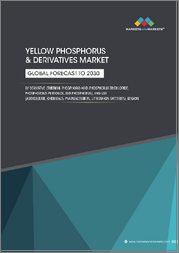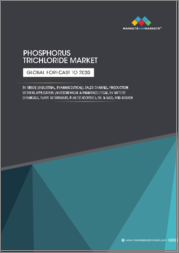
|
시장보고서
상품코드
1488067
삼염화인 제조 플랜트 프로젝트 보고서(2024년) : 산업 동향, 플랜트 설립, 기계, 원재료, 투자 기회, 비용, 수익Phosphorous Trichloride Manufacturing Plant Project Report 2024: Industry Trends, Plant Setup, Machinery, Raw Materials, Investment Opportunities, Cost and Revenue |
||||||
이 보고서는 삼염화인 제조 플랜트 설립을 위한 완벽한 로드맵을 제공합니다. 종합적인 시장 개요에서 관련 단위 작업, 원재료 요구 사항, 유틸리티 요구 사항, 인프라 요구 사항, 기계 및 기술 요구 사항, 인력 요구 사항, 포장 요구 사항, 운송 요구 사항과 같은 미시적 수준의 정보까지 포괄합니다. 삼염화인 프로젝트 보고서는 자본 투자, 프로젝트 자금, 운영 비용, 손익 예측, 고정비 대 변동비, 직접비 및 간접비, 예상 ROI 및 순현재가치(NPV), 손익 계산, 재무 분석 등 프로젝트 경제에 대한 심층적인 인사이트를 제공합니다.
본 보고서에서 다루는 주요 질문들
삼염화인 시장은 지금까지 어떻게 발전해 왔으며 앞으로 어떻게 발전할 것인가?
세계 삼염화인 시장 세분화는?
세계 삼염화인 시장의 지역별 분류는?
삼염화인 산업에서 각종 원료의 가격 동향은?
삼염화인 산업의 구조와 주요 업체는?
삼염화인 제조 플랜트에서 이루어지는 다양한 단위 작업은 무엇인가?
삼염화인 삼염화인 제조 플랜트 설립에 필요한 총 면적은?
삼염화인 제조 플랜트의 레이아웃은?
삼염화인 제조 플랜트 설립에 필요한 기계설비는?
삼염화인 제조 플랜트 설립에 필요한 원료는?
삼염화인 삼염화인 제조 플랜트 설립에 필요한 포장 조건은?
삼염화인 제조 플랜트 설립에 필요한 운송은 무엇인가?
삼염화인 제조 플랜트 설립에 필요한 유틸리티는 무엇인가?
삼염화인 제조 플랜트 설립에 필요한 인적 자원은?
삼염화인 제조 플랜트 설립에 필요한 인프라 비용은?
삼염화인 제조 플랜트 설립에 필요한 자본 비용은?
삼염화인 제조 플랜트의 운영 비용은?
최종 제품의 가격 메커니즘은 어떻게 해야 하는가?
삼염화인 제조 플랜트의 손익은 어떻게 되는가?
수지가 균형을 이루기까지 얼마나 걸리는가?
삼염화인 삼염화인 제조 플랜트 설립의 이익 예측은?
삼염화인 산업의 주요 성공요인과 위험요인은 무엇인가?
삼염화인 제조 플랜트 설립에 필요한 주요 규제 절차와 요건은?
삼염화인 제조 플랜트 설립에 필요한 주요 인증은?
목차
제1장 서문
제2장 조사 범위와 조사 방법
- 조사 목적
- 이해관계자
- 조사 방법
제3장 주요 요약
- 시장 시나리오
- 원재료 수요
- 수입 예측
- 지출 예측
- 이익 분석
제4장 세계의 삼염화인 시장
- 시장 개요
- 과거와 현재의 시장 실적
- COVID-19의 영향
- 시장 내역 : 부문별
- 시장 내역 : 지역별
- 가격 동향
- 시장 예측
- 경쟁 상황
제5장 상세한 프로세스 플로우
- 제품 개요
- 다양한 단위 조작
- 품질 보증 기준
- 기술 시험
- 매스 밸런스와 원재료 요건
제6장 프로젝트 상세, 요건 및 관련 비용
- 토지, 입지, 부지 개발
- 플랜트 레이아웃
- 플랜트 기계
- 원재료
- 포장
- 수송
- 유틸리티
- 인재 요건과 임금
제7장 융자와 자금 원조
제8장 프로젝트 경제학
- 프로젝트 자본 비용
- 기술 경제 파라미터
- 수입 예측
- 지출 예측
- 제품 가격과 마진
- 과세
- 감가상각
- 재무 분석
제9장 규제 절차와 승인
제10장 인증 요건
제11장 주요 성공요인과 위험요인
제12장 전략적 제안
제13장 성공한 벤처기업 사례 연구
ksm 24.06.07IMARC Group's report, titled "Phosphorous Trichloride Manufacturing Plant Project Report 2024: Industry Trends, Plant Setup, Machinery, Raw Materials, Investment Opportunities, Cost and Revenue" provides a complete roadmap for setting up a phosphorous trichloride manufacturing plant. It covers a comprehensive market overview to micro-level information such as unit operations involved, raw material requirements, utility requirements, infrastructure requirements, machinery and technology requirements, manpower requirements, packaging requirements, transportation requirements, etc. The phosphorous trichloride project report provides detailed insights into project economics, including capital investments, project funding, operating expenses, income and expenditure projections, fixed costs vs. variable costs, direct and indirect costs, expected ROI and net present value (NPV), profit and loss account, financial analysis, etc.
Phosphorous trichloride, a highly significant chemical compound, occupies a pivotal role in the domain of inorganic chemistry. With the chemical formula PCl3, it comprises phosphorus and chlorine atoms and stands out for its exceptional reactivity and versatility as a chemical reagent. Phosphorous trichloride finds widespread use in various organic synthesis processes, particularly in converting alcohols to alkyl chlorides. This introduction provides a concise glimpse into the multifaceted nature of phosphorous trichloride and its significance in advancing chemical processes and industries.
Phosphorous trichloride offers several advantages and finds diverse applications in various fields. As a highly reactive chemical reagent, it plays a crucial role in organic synthesis, converting alcohols to alkyl chlorides, and facilitating the production of numerous organic compounds. Additionally, it serves as a key precursor in the manufacturing of phosphorus oxychloride (POCl3) and other phosphorus-containing compounds, widely utilized in the chemical industry. Its versatility extends to applications in agriculture, where it finds use as a pesticide and fumigant. Furthermore, phosphorous trichloride is employed in the production of pharmaceuticals and dyes. Its reactivity and wide-ranging applications make it an indispensable compound in advancing various industrial processes and scientific research.
The phosphorous trichloride market is driven by numerous key market drivers that contribute to its growth and demand. One of the primary drivers is the growing adoption of this compound in organic synthesis processes is boosting the market growth. Furthermore, the rising use of phosphorous trichloride as a pesticide and fumigant in agriculture is contributing to market demand. Additionally, the increasing demand for pharmaceuticals and dyes in the healthcare and textile industries is driving the use of phosphorous trichloride in their synthesis. Moreover, ongoing research and development activities are exploring new applications for phosphorous trichloride, creating potential growth opportunities in the market. This, in turn, is projected to propel the global market in the coming years.
The following aspects have been covered in the report on setting up a phosphorous trichloride manufacturing plant:
Market Analysis:
Market Performance
Market Breakup by Segment
Market Breakup by Region
Price Analysis
Impact of COVID-19
Market Outlook
The report provides insights into the landscape of the phosphorous trichloride industry at the global level. The report also provides a segment-wise and region-wise breakup of the global phosphorous trichloride industry. Additionally, it also provides the price analysis of feedstocks used in the manufacturing of phosphorous trichloride, along with the industry profit margins.
Detailed Process Flow:
Product Overview
Unit Operations Involved
Mass Balance and Raw Material Requirements
Quality Assurance Criteria
Technical Tests
The report also provides detailed information related to the process flow and various unit operations involved in a phosphorous trichloride manufacturing plant. Furthermore, information related to mass balance and raw material requirements has also been provided in the report with a list of necessary quality assurance criteria and technical tests.
Project Details, Requirements and Costs Involved:
Land, Location and Site Development
Plant Layout
Machinery Requirements and Costs
Raw Material Requirements and Costs
Packaging Requirements and Costs
Transportation Requirements and Costs
Utility Requirements and Costs
Human Resource Requirements and Costs
The report provides a detailed location analysis covering insights into the land location, selection criteria, location significance, environmental impact, and expenditure for setting up a phosphorous trichloride manufacturing plant. Additionally, the report also provides information related to plant layout and factors influencing the same. Furthermore, other requirements and expenditures related to machinery, raw materials, packaging, transportation, utilities, and human resources have also been covered in the report.
Project Economics:
Capital Investments
Operating Costs
Expenditure Projections
Revenue Projections
Taxation and Depreciation
Profit Projections
Financial Analysis
The report also covers a detailed analysis of the project economics for setting up a phosphorous trichloride manufacturing plant. This includes the analysis and detailed understanding of capital expenditure (CapEx), operating expenditure (OpEx), income projections, taxation, depreciation, liquidity analysis, profitability analysis, payback period, NPV, uncertainty analysis, and sensitivity analysis. Furthermore, the report also provides a detailed analysis of the regulatory procedures and approvals, information related to financial assistance, along with a comprehensive list of certifications required for setting up a phosphorous trichloride manufacturing plant.
Key Questions Answered in This Report?
How has the phosphorous trichloride market performed so far and how will it perform in the coming years?
What is the market segmentation of the global phosphorous trichloride market?
What is the regional breakup of the global phosphorous trichloride market?
What are the price trends of various feedstocks in the phosphorous trichloride industry?
What is the structure of the phosphorous trichloride industry and who are the key players?
What are the various unit operations involved in a phosphorous trichloride manufacturing plant?
What is the total size of land required for setting up a phosphorous trichloride manufacturing plant?
What is the layout of a phosphorous trichloride manufacturing plant?
What are the machinery requirements for setting up a phosphorous trichloride manufacturing plant?
What are the raw material requirements for setting up a phosphorous trichloride manufacturing plant?
What are the packaging requirements for setting up a phosphorous trichloride manufacturing plant?
What are the transportation requirements for setting up a phosphorous trichloride manufacturing plant?
What are the utility requirements for setting up a phosphorous trichloride manufacturing plant?
What are the human resource requirements for setting up a phosphorous trichloride manufacturing plant?
What are the infrastructure costs for setting up a phosphorous trichloride manufacturing plant?
What are the capital costs for setting up a phosphorous trichloride manufacturing plant?
What are the operating costs for setting up a phosphorous trichloride manufacturing plant?
What should be the pricing mechanism of the final product?
What will be the income and expenditures for a phosphorous trichloride manufacturing plant?
What is the time required to break even?
What are the profit projections for setting up a phosphorous trichloride manufacturing plant?
What are the key success and risk factors in the phosphorous trichloride industry?
What are the key regulatory procedures and requirements for setting up a phosphorous trichloride manufacturing plant?
What are the key certifications required for setting up a phosphorous trichloride manufacturing plant?
Table of Contents
1 Preface
2 Scope and Methodology
- 2.1 Study Objectives
- 2.2 Stakeholders
- 2.3 Research Methodology
3 Executive Summary
- 3.1 Market Scenario
- 3.2 Raw Material Requirements
- 3.3 Income Projections
- 3.4 Expenditure Projections
- 3.5 Profit Analysis
4 Global Phosphorous Trichloride Market
- 4.1 Market Overview
- 4.2 Historical and Current Market Performance
- 4.3 Impact of COVID-19
- 4.4 Market Breakup by Segment
- 4.5 Market Breakup by Region
- 4.6 Price Trends
- 4.6.1 Raw Material Price Trends
- 4.6.2 Phosphorous Trichloride Price Trends
- 4.6.3 Product Margins
- 4.7 Market Forecast
- 4.8 Competitive Landscape
- 4.8.1 Market Structure
- 4.8.2 Key Players
- 4.8.3 Profiles of Key Players
5 Detailed Process Flow
- 5.1 Product Overview
- 5.2 Various Types of Unit Operations Involved
- 5.3 Quality Assurance Criteria
- 5.4 Technical Tests
- 5.5 Mass Balance and Raw Material Requirements
6 Project Details, Requirements and Costs Involved
- 6.1 Land, Location and Site Development
- 6.1.1 Overview of Land Location
- 6.1.2 Selection Criteria and Significance
- 6.1.3 Location Analysis
- 6.1.4 Project Planning and Phasing of Development
- 6.1.5 Environmental Impact
- 6.1.6 Land Requirement and Costs
- 6.2 Plant Layout
- 6.2.1 Overview
- 6.2.2 Importance and Essentials
- 6.2.3 Layout
- 6.2.4 Factors Influencing Layout
- 6.3 Plant Machinery
- 6.3.1 Machinery Requirements
- 6.3.2 Machinery Costs
- 6.3.3 Machinery Suppliers (Provided on Request)
- 6.3.4 Machinery Pictures
- 6.4 Raw Materials
- 6.4.1 Raw Material Requirements
- 6.4.2 Raw Material Details and Procurement
- 6.4.3 Raw Material Costs
- 6.4.4 Raw Material Suppliers (Provided on Request)
- 6.4.5 Raw Material and Final Product Pictures
- 6.5 Packaging
- 6.5.1 Packaging Overview
- 6.5.2 Packaging Requirements
- 6.5.3 Packaging Material Details and Procurement
- 6.5.4 Packaging Costs
- 6.5.5 Packaging Material Suppliers (Provided on Request)
- 6.6 Transportation
- 6.6.1 Transportation Overview
- 6.6.2 Transportation Requirements
- 6.6.3 Transportation Costs
- 6.7 Utilities
- 6.7.1 Energy Requirements and Costs
- 6.7.2 Water Requirements and Costs
- 6.7.3 Costs Related to Other Utilities
- 6.8 Human Resource Requirements and Wages
- 6.8.1 Total Human Resource Requirement
- 6.8.2 Salary Costs
- 6.8.3 Overview of Employee Policies
7 Loans and Financial Assistance
8 Project Economics
- 8.1 Capital Cost of the Project
- 8.2 Techno-Economic Parameters
- 8.3 Income Projections
- 8.4 Expenditure Projections
- 8.5 Product Pricing and Margins
- 8.6 Taxation
- 8.7 Depreciation
- 8.8 Financial Analysis
- 8.8.1 Liquidity Analysis
- 8.8.2 Profitability Analysis
- 8.8.2.1 Payback Period
- 8.8.2.2 Net Present Value
- 8.8.2.3 Internal Rate of Return
- 8.8.2.4 Profit and Loss Account
- 8.8.3 Uncertainty Analysis
- 8.8.4 Sensitivity Analysis
- 8.8.5 Economic Analysis
















